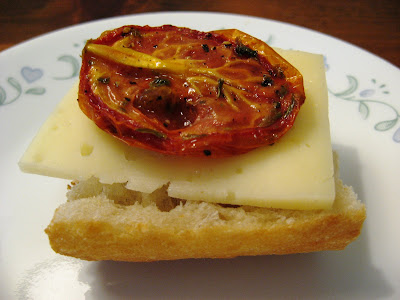The girls ran us through the basics of making and maintaining sourdough starter and kneading, proofing, and baking bread. We also tasted two yogurts they had made the night before: raw milk (runny, rich and grassy-tasting) and pasteurized milk (firmer and somewhat bland in flavor). We also made butter, which (with the aid of modern technology) is crazy easy: all you do is whip cream with a Cuisinart or electric mixer until the butter separates from the buttermilk. Then you knead the butter in your hands to squeeze out the last of the buttermilk and wash it off in cool water. Add salt to taste and wrap in wax paper and you're done!
After gorging ourselves on warm, fresh bread with butter and yogurt with maple syrup and honey, we got sent home with parting gifts: sourdough starter, butter and buttermilk, raw milk in glass ball jars for making yogurt, and bread dough to bake.
But here comes the depressing part: I hate to admit it, but since Saturday I've tried on two--two--occasions to make yogurt, and failed. And it seemed so easy. All you have to do is heat the milk to 180°, let it cool to 110°, then add it to a few tablespoons of plain commercial yogurt that you've placed in a warmed ball jar, mix and let stand undisturbed in a warm place for 8-12 hours. After that, you should magically have yogurt. But all I've had both times was stringy, gooey warm milk that smelled like yogurt. Yuck! I suspect that my milk temperatures have been off, since I've been eyeballing it (I don't have a candy thermometer, but I think I need to get one). Either that, or the warm place I've been keeping the yogurt-to-be (a preheated oven that I then turned off) hasn't maintained temperature overnight. Who knows? I'm almost afraid to share this in case it goes awry again, but I have another batch in the oven right now. I still didn't use a thermometer, and if it doesn't work I'll buy one this weekend and try yet again. Oh well. Making yogurt (or failing to make yogurt, as the case may be) is really fun--it feels less like cooking and more like a second grade science experiment (baking soda/vinegar volcanoes, anyone?).
So as not to end this post on a down note, I'll display my workshop success below. Behold, the most basic and most satisfying of foods: freshly-baked bread. Mine is the long baguette in the front to the right.















.JPG) A lot of cooks are intimidated by artichokes, which are thorny on the outside and filled with the sharp "choke" on the inside (I always wonder, with foods like these, how it was discovered that they were edible at all). As a result, it seems that people typically just steam or boil artichokes whole. This is, of course, a delicious and perfectly appropriate way to enjoy the vegetable, especially when you dip the leaves in melted butter. But it's really not that hard to trim an artichoke for use in all kinds of dishes: a little time consuming, maybe, but definitely worth it. And even though the method might seem wasteful, all of what you'll be left with will be tender and easy to eat. Here's how you do it:
A lot of cooks are intimidated by artichokes, which are thorny on the outside and filled with the sharp "choke" on the inside (I always wonder, with foods like these, how it was discovered that they were edible at all). As a result, it seems that people typically just steam or boil artichokes whole. This is, of course, a delicious and perfectly appropriate way to enjoy the vegetable, especially when you dip the leaves in melted butter. But it's really not that hard to trim an artichoke for use in all kinds of dishes: a little time consuming, maybe, but definitely worth it. And even though the method might seem wasteful, all of what you'll be left with will be tender and easy to eat. Here's how you do it:




 'Nuff said.
'Nuff said.



















